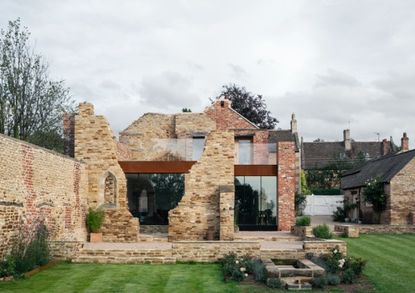Go inside this stunning contemporary extension on a 17th-century building
A contemporary extension gives historic ruins new life thanks to bold design by Will Gamble Architects

This stunning contemporary extension could have easily looked very different. When Will Gamble Architects took on The Parchment Works, a project in Northamptonshire which includes the ruins of a 17th-century parchment paper factory, the owners asked for the Victorian cottage and old cattle shed to be converted, but to demolish the adjacent ruins.
Instead, Will Gamble and his team created a breathtaking design which links all three buildings, incorporating the remnants of the factory to preserve the history of the site and deliver an open and unique home. Check out more beautiful modern homes.

The side view of the extension reveals a large picture window into the dining area
The bold glass and a Corten-steel box extension to the listed Victorian cottage introduces an open-plan kitchen, living and dining area, which sit snugly within the ruin’s walls. It links to the cattle shed, which now features a main bedroom and ensuite.

Timber joists and the ruin's masonry walls are visible throughout the extension. The elegant, contemporary kitchen was designed with the watchword 'minimalism' to ensure it would not detract from the striking original features.

Light floods in to the kitchen-dining area through the full-height glass of the extension. Simple and natural materials are used throughout – including white-washed oak floorboards with a chunky concrete skirting.

An archaeologist oversaw every step of this project due to planning regulations, and wherever possible materials were repurposed. Salvaged local bricks form the walls of the extension, while stone slabs from the floor of the old parchment factory line the base of the courtyard.

"The whole concept was not to cover anything up,’ says Will. "Even where old rusty nails were set in the walls, we didn’t want to take them out. It was a very honest project – we just made the most of the materials that were around us."
Have a look at this design project which transforms a former agricultural shed into a modern home with double height library.
Be The First To Know
The Livingetc newsletter is your shortcut to the now and the next in home design. Subscribe today to receive a stunning free 200-page book of the best homes from around the world.
Emma Ledger is not only an esteemed lifestyle journalist but is also an illustrator. Her words appear in publications such as Livingetc, The Independent, The Mirror, The Sun and Fabulous magazine, while her drawings have made it onto maps and cards. She is also a mentor at Centrepoint.
-
 These 12 Best Table Lamps for Your Desk — Perfect Glows for a Creative Home Office
These 12 Best Table Lamps for Your Desk — Perfect Glows for a Creative Home OfficeThe best table lamps for your desk is have a soft, targeted glow. Elevate your WFH set-up with these stylish picks endorsed by Style Editor Brigid Kennedy
By Brigid Kennedy Published
-
 The Nespresso VertuoPlus is 30% Off for President's Day, and it's Kim Kardashian's Coffee Maker of Choice
The Nespresso VertuoPlus is 30% Off for President's Day, and it's Kim Kardashian's Coffee Maker of ChoiceThis sleek and stylish coffee maker was spotted in Kim's home bar, and you can currently save $60 if you buy yours from Amazon
By Lilith Hudson Published
-
 The simple way to a more sustainable and stylish life with Fisher & Paykel
The simple way to a more sustainable and stylish life with Fisher & PaykelThis incredible new tech saves time, energy and has become the washing machine you need to know about
By Sponsored Published
-
 Forget Cottagecore - Flora Fantasia by House of Hackney is Cottage hardcore
Forget Cottagecore - Flora Fantasia by House of Hackney is Cottage hardcoreHouse of Hackney's Flora Fantasia collection blends the romanticised rural aesthetic with riotous punk elements
By Jacky Parker Published
-
 Bert & May's new hexagon tiles collection is tapping into one of this year's biggest micro trends
Bert & May's new hexagon tiles collection is tapping into one of this year's biggest micro trendsTap into the microtrend for hexagon tiles and make myriad patterns with this new collection from Bert & May
By Jacky Parker Published
-
 Matthew Williamson’s tip for renovating a house on a budget is so simple, but incredibly effective
Matthew Williamson’s tip for renovating a house on a budget is so simple, but incredibly effectiveRenovating a house on a budget? See the savvy ways to control costs when managing an interior redesign
By Jacky Parker Published
-
 The fabulous new Matthew Williamson furniture collection is a cocktail of color and print
The fabulous new Matthew Williamson furniture collection is a cocktail of color and printThis decorative Matthew Williamson furniture is the beautiful result of collaboration with Roome London
By Jacky Parker Published
-
 Out & Out's new furniture collection is full of stylish storage solutions
Out & Out's new furniture collection is full of stylish storage solutionsThis stylish storage will have your home organised in a jiffy - whatever its size
By Jacky Parker Published
-
 Explore Sandra Bullock’s former coastal chic home in Georgia
Explore Sandra Bullock’s former coastal chic home in GeorgiaSandra Bullock has just sold her beautiful island beach house, giving us a glimpse at her coastal-inspired interior style.
By Lotte Brouwer Published
-
 On your marks: new H&M furniture, lighting and homeware for SS21 about to drop
On your marks: new H&M furniture, lighting and homeware for SS21 about to dropThe new H&M furniture, lighting and homeware collections drop on 4 Feb, so earmark your favourite pieces now
By Jacky Parker Published









